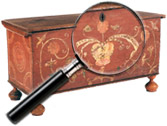|
|
Weller Potter ‘Coppertone’
Designed by Weller ceramic artist Rudolph Lorber, the Coppertone line of pottery featuring a rich, mottled green glaze was an instant hit, and has been popular with pottery lovers ever since its introduction.
First appearing in advertisements in House and Garden and House Beautiful Magazines, Weller Coppertone pottery was an almost immediate success with gardeners, collectors and decorators. Coppertone pottery was made in a wide variety of sizes and shapes, and [...] Click here to continue reading.
Celt
Small celts were used as skinning tools. Larger examples could have been used as small chopping devices, like a small ax. Sizes can vary greatly, and they can be made out of slate or granite. They would correctly be classified as tools, as would a stone ax or hammer.
Reference note by p4A editorial staff, November 2011.
Limbert Furniture
From 1889-1892, Charles Limbert and his partner, Phillip V. Klingman, operated Klingman and Limbert Co., sales agents for furniture manufactures located mainly in Grand Rapids, Michigan. From 1906-1922 Charles Limbert operated a furniture factory in Holland, Michigan.
Charles P. Limbert’s Limbert Furniture Company produced a popular and affordable line of furniture until 1922, when poor health forced him to sell his interest in the company. Although his designs were said to be [...] Click here to continue reading.
Chen Chi (Chinese, American, 1912 to 2005)
The use of the hand scroll in Chinese painting appears to have evolved some three thousand years ago, from the practice of binding and rolling written documents to facilitate storage.[1] Painting in this format likely originated as a means of embellishing text through illustration. Paper (or silk) would be attached at the left to a round wooden roller upon which it was wound for storage, and at [...] Click here to continue reading.
Carl Peterson (American, 1869 to 1969)
From St. James, Minnesota, Carl Peterson was an expert blacksmith, cabinetmaker and accomplished mason who lived to be 100 years old. Sometime during the 20th century, he set out to create an “Environmental Sculpture Garden of Nature,” whimsical and powerful depictions of concrete and steel showing animals and primitive people. It is thought that his work is the most significant folk art ever created in concrete.
Information [...] Click here to continue reading.
Laurence Christie Edwardson (1904-1995)
Laurence Christie Edwardson was born in Waltham, Massachusetts and settled in Kensington, Connecticutand also lived in New York City. His artistic training included study at the Hartford Art School, the Connecticut Academy of Fine Arts, and the New Britain Art League. Edwardson belonged to the Connecticut Art Association and exhibited in a variety of New England locations. Although Edwardson was from the North, the landscapes and culture of the South [...] Click here to continue reading.
John Brewster Jr. (1766-1854)
John Brewster Jr. was a successful New England portrait artist as well as one of the first individuals to learn American Sign Language. Brewster was born deaf and enrolled at the newly opened Connecticut Asylum for the Education and Instruction of the Deaf and Dumb at the age of 51, where he was present during the development of American Sign Language. Art historians have theorized that Brewster’s lack of hearing [...] Click here to continue reading.
Feliciano Bejar (Mexican, American, 1920 to 2007)
A primarily a self-taught artist, Bejar’s formal education was severely limited by his family’s financial situation and by the nearly paralytic polio which struck him at the age of 8. He briefly attended the Salesian College school before that institution was closed by the government. Bejar believed this lack of education allowed him a free approach to his art.
Known for his experimental pieces incorporating metal, glass, [...] Click here to continue reading.
C.R. Parker (1799-1849)
An itinerant artist, C.R. Parker traveled extensively throughout Louisiana, Mississippi, Alabama and Georgia, soliciting portrait commissions during the 1830′s and 1840′s. Delicate handling and fine draftsmanship characterizes Parker’s work. Known for imbuing his sitters with an impression of deep character, Parker highlighted the sitter’s fashionable dresses, hairstyles, and jewelry.
-Information courtesy of Neal Auctions.
William S. Robinson (American, 1861-1945)
William S. Robinson was an important member of the Old Lyme Art Colony in Lyme, Connecticut in the early 20th century. Following the death of patron Florence Griswold in 1937, Robinson left Old Lyme and relocated to Biloxi, Mississippi, at the recommendation of his friend, noted New Orleans artist William Woodward. He continued to create impressionistic landscapes, trading the Connecticut scenery for the charming images of shrimp boats and [...] Click here to continue reading.
|
Recent Articles
- Charles Alfred Meurer – American Artist & Tromp L’Oeil Artist
- Sendak, Maurice – American Artist & Writer
- Godie, Lee – American Artist
- Davis, Vestie – American Artist
- Bartlett, Morton – American Artist
- Mackintosh, Dwight – American Artist
- Evans, Minnie Jones – African-American Artist
- Mumma, Ed (Mr. Eddy) – American Artist
- Nice, Don – American Artist
- Savitsky, John (Jack) – American Artist
- Gordon, Harold Theodore (Ted) – American Artist
- Dial, Thornton – African-American Artist
- Doyle Sam – American Artist
- Johnson, Lester Frederick – American Artist
- Finster, Howard – American Artist
|
|
